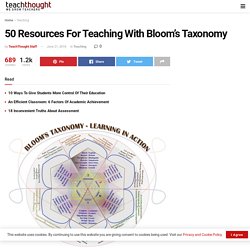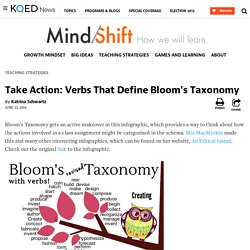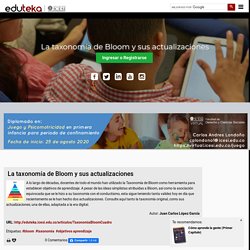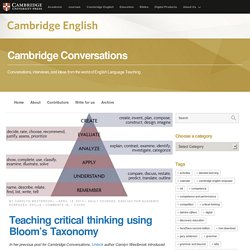

50 Resources For Teaching With Bloom's Taxonomy - Simple suggestions for applying the taxonomy to kindergarten-level children.

Lesson Planet: This source gives the goods on creating complete lesson plans using Bloom’s Taxonomy. Prezi: Enjoy this stylish Prezi presentation on Bloom’s Taxonomy. Iowa State U.: This is a wonderful tool to build learning objectives based on Bloom’s Taxonomy. The Differentiator: Teachers and students can work together using this source to design creative activities; provides resources, content and the verbs. Slideshare: Based on Bloom’s Taxonomy, this presentation shows how to apply the principles for high-order technology skills. The Literary Link: This is a list of book review questions to use in the classroom. 4 Strategies For Teaching With Bloom's Taxonomy.
4 Strategies For Teaching With Bloom’s Taxonomy by TeachThought Staff Bloom’s Taxonomy can be a powerful tool to transform teaching and learning.

By design, it focuses attention away from content and instruction, and instead emphasizes the “cognitive events” in the mind of a child. And this is no small change. For decades, education reform has been focused on curriculum, assessment, instruction, and more recently standards, and data, with these efforts only bleeding over into how students think briefly, and by chance. This stands in contrast to the characteristics of the early 21st century, which include persistent connectivity, dynamic media forms, information-rich (digital and non-digital) environments, and an emphasis on visibility for pretty much everything. Blooms. Comprendiendo la Taxonomía - Taxonomía de marzano. {12 Days of Literacy} Infographic: Marzano's 9 Effective Instructional Strategies. Effective schools make a big difference in student achievement.

Effective leadership makes a positive difference, too. Effective teachers, however, directly impact student learning and achievement. It’s been shown that teachers who have a large repertoire of effective instructional strategies teach differently. They’re more intentional in their objectives, strategies, and intended outcomes. And, have better results. Robert Marzano, an educational leader, conducted a meta-analysis of instructional strategies to determine which were the most effective.
A literacy-rich environment in classrooms and schools, for example, is an important K-12 foundation to support and extend effective instruction. . {12 Days of Literacy} Tool 10 – Marzano’s 9 Instructional Strategies. Otro gráfico sobre la taxonomía de Bloom. Take Action: Verbs That Define Bloom’s Taxonomy. Bloom’s Taxonomy gets an active makeover in this infographic, which provides a way to think about how the actions involved in a class assignment might be categorized in the schema.

Mia MacMeekin made this and many other interesting infographics, which can be found on her website, An Ethical Island. Check out the original link to the infographic. Katrina Schwartz Katrina Schwartz is a journalist based in San Francisco. Bloom's Taxonomy & Webb's DOK. Empowering Student Relationships With Media. Debates over children and media use are nothing new, but the technologies by which children primarily interact with media have changed significantly.

Most guidelines related to "screen time" were developed when television was the dominant media, but new technologies are making us question the value of older research. In its most recent report on the subject, the American Academy of Pediatrics makes reference to "important positive and prosocial effects of media use," and a call for expanding media education programs in schools. While more dedicated media education in schools would be great, it is little more than a pipe dream in the current climate of low budgets and high-stake tests. It is therefore incumbent on individual educators to help students interact with media in ways that are critical and empowering. Bloom's Taxonomy & Webb's DOK. Educational Technology and Mobile Learning: Excellent Worksheets on Bloom's Digital Taxonomy.
The Best Critical Thinking Questions For Engaging Students. 24 iPad Apps to Support Bloom’s Taxonomy. Via eSchool News Bloom’s Taxonomy, introduced in the 1950s as a system of organizing learning objectives into a pyramid, traditionally has started with creating at the top, followed by evaluating, analyzing, applying, understanding, and remembering.

Some educators today are flipping the triangle so that remembering is on top, followed by understanding, applying, analyzing, evaluating, and creating on the bottom. During an edWeb.net webinar, educational technologist Kathy Schrock presented a variety of apps for iPads that can boost student engagement and collaboration, and that can be used for teaching and learning according to Bloom’s Taxonomy.
“Remembering” apps:Diigo – A social bookmarking tool; teachers can use this app on an iPad to add relevant bookmarks, or create their own account and share. Lists can be organized into sub lists.Evernote – A “must-have” app. 2 Sensacionales infografías para abordar la Taxonomía de Bloom en el aula. The Best Resources For Helping Teachers Use Bloom’s Taxonomy In The Classroom. Bloom’s & SOLO ‘are not Just Colorful Posters we Hang on the Wall’ is my two-part series at Education Week Teacher.

Bloom’s Taxonomy is talked about a lot in educational circles. However, if you believe a recent survey of visits to 23,000 U.S. classrooms, the higher-order thinking skills it’s ideally designed to promote doesn’t get much use. And I can understand why. It’s easy to get caught-up in the day-to-day work involved in teaching a class or multiple classes, and it’s easy to fall into the trap of doing the “usual stuff” and not “think out of the box.” Las taxonomías de Bloom y YouTube #infografia #infographic. Taxonomías de Bloom con verbos #infografia #infographic. Mark Anderson sur Twitter : "Revised Version of Bloom's Taxonomy questioning for Higher Thinking.
Taxonomía de Bloom de habilidades de pensamiento. Recomendamos consultar el siguiente artículo:TAXONOMÍA DE BLOOM PARA LA ERA DIGITAL Han pasado más de cincuenta años y la Taxonomía de Bloom continúa siendo herramienta fundamental para establecer objetivos de aprendizaje.

En el 2000 fue revisada por uno de sus discípulos quien, para cada categoría, cambió tanto el uso de sustantivos por verbos, como su secuencia. Bloom's 'Digital' Taxonomy - Printable Reference Table. The 6 Levels Of Bloom's Taxonomy, Explained With Active Verbs. How To Use Bloom’s Taxonomy To Write Learning Outcomes.
By: Scott Davis Business Analyst, Pearson It is often quite difficult to relate inputs to outcomes in the world of education.

Traditionally, much work has been done to develop and provide inputs into the process of education. These inputs, such as a textbook, an assessment, a learning technology or platform, a course, a qualification, a high-stakes test or professional development for teachers are put into the hands of an educational leader, a skillful teacher, or an eager student. And, for all of the investment, expertise, and care that go into their creation, that has typically been where the involvement ends.
Rarely has one been able to measure or predict the learning outcomes from using these inputs. If we are going to really understand how we might be impacting student learning we must do two things. It may be difficult to know where to start in writing a student learning outcome. The committee identified three domains of educational activities or learning (Bloom, 1956): Bloom, B. 84 (And Counting) Bloom's Taxonomy Tools Worth Trying. Teaching critical thinking using Bloom’s Taxonomy - Cambridge Conversations.
In her previous post for Cambridge Conversations, Unlock author Carolyn Westbrook introduced the basics of teaching Critical Thinking in ELT.

Today, she explores Bloom’s Taxonomy. Bloom’s Taxonomy of Learning Objectives classifies a number of skills which can be used to teach critical thinking. The six skills are often depicted as a triangle, as above. However, representing the skills like this gives the impression of a hierarchical approach to critical thinking. It seems to suggest that the Lower Order Thinking Skills (remember, understand and apply) must be acquired before the Higher Order Thinking Skills (analyze, evaluate and create) can be learnt. This is not necessarily the case, however. But what do the six skills really mean? • Remember: can students recall information they have read or heard? Creative Visualizations of Bloom's Taxonomies! Taxonomía Bloom para la era digital Sociedad Knowmad - Ecuador.
Using Bloom's Taxonomy In The 21st Century: 4 Strategies For Teaching. 6 Strategies For Teaching With Bloom’s Taxonomy by TeachThought Staff Bloom’s Taxonomy can be a powerful tool to transform teaching and learning. By design, it focuses attention away from content and instruction, and instead emphasizes the ‘cognitive events’ in the mind of a child. And this is no small change. For decades, education reform has been focused on curriculum, assessment, instruction, and more recently standards, and data, with these efforts only bleeding over into how students think briefly, and by chance. This stands in contrast to the characteristics of the early 21st-century, which include persistent connectivity, dynamic media forms, information-rich (digital and non-digital) environments, and an emphasis on visibility for pretty much everything. 1.
Educational Technology and Mobile Learning: Twitter Aligned with Blooms' Taxonomy: A Must Have Poster for Your Class. 22 Ways To Use Twitter For Learning Based On Bloom's Taxonomy. Last year we created a “twitter spectrum,” an image that clarified different ways that twitter could be used in the classroom in (hopefully) authentic ways. TeachBytes has followed that up with an excellent graphic of their own that uses a pure Bloom’s Taxonomy approach. The specific ideas range from “remix trending tweets with video and music” to creating concept maps showing the relationship between tweets. We must admit to going back and forth over the exact fit of a social media platform like twitter in a formal (or informal) learning environment. Clearly it’s a great way to skim and monitor information streams, but just like we wouldn’t use sing Shakespearean sonnets to toddlers at birthday parties, using twitter as an in-depth critical thinking tool requires a bit of squinting, even as an Avante-garde 21st century learning tool.
Unless you’re using it as a cultural survey of sorts. 44 Prompts Merging Reflective Thinking With Bloom's Taxonomy. 44 Prompts Merging Reflective Thinking With Bloom’s Taxonomy by Peter Pappas It’s been four years since I first published my “Taxonomy of Reflection.” My interest in reflective thinking is rooted in a simple but powerful statement by Donald Finkel who wrote that teaching should be thought of as “providing experience, provoking reflection.” (Teaching with Your Mouth Shut) Most school mission statements include a reference to “fostering life-long learners.”
Unfortunately, self-reflection is rarely taught in school. Creating Understanding - Beyond Bloom. This weekend I was leading a Making the PYP Happen workshop at my school for our new staff. In designing the engagements for this workshop I drew heavily on the Visible Thinking routines of Harvard Project Zero. A number of years ago, when I was working at the International School of Amsterdam, I was lucky enough not only to attend the PZ summer institute, but also to be part of a year long cohort working with Mark Church (who was at that time a middle school teacher at ISA) about teaching for understanding.
Following this ISA embraced the visible thinking routines and Ron Ritchhart visited the school many times to help get this started. Más sobre la taxonomía de Bloom y el flipped classroom… 6 Alternatives To Bloom's Taxonomy For Teachers - This post is updated from an article we published in April. At the end of the day, teaching is about learning, and learning is about understanding. And as technology evolves to empower more diverse and flexible assessments forms, constantly improving our sense of what understanding looks like–during mobile learning, during project-based learning, and in a flipped classroom–can not only improve learning outcomes, but just might be the secret to providing personalized learning for every learner.
This content begs the question: why does one need alternatives to the established and entrenched Bloom’s? Because Bloom’s isn’t meant to be the alpha and the omega of framing instruction, learning, and assessment. So with apologies to Bloom (whose work we covered recently), we have gathered five alternatives to his legendary, world-beating taxonomy, from the TeachThought Simple Taxonomy, to work from Marzano to Fink, to the crew at Understanding by Design. Does Bloom’s Taxonomy still have a role to play in e-learning? Mayes and de Freitas (2004) state that the use of technology can be used to achieve better learning outcomes, more effective assessments or a more cost effective way of bringing learning environments to students; and that reforming practice requires transformation of the understanding of the principles. So what are the pedagogical principles behind “e” learning?
The definitions of e-learning are numerous and varied but one excepted definition is "learning facilitated and supported through the use of information and communications technology", (JISC, 2003). In their report (2004) Mayes and de Freitas go on to surmise that in this framework (ie e-learning) there are no models for e-learning per se, only e-enhancements of models of learning in general. Blooms Taxonomy (1956) was developed to classify the complexity of questions asked in assessments, ultimately becoming a system for classifying learning outcomes. References. Bloom’s Blooming Taxonomy. A Powerful App For Every Level Of Bloom's Taxonomy. A Primer In Effective Questioning Strategies For Classroom & eLearning - By Rosa Fattahi, WizIQ. The 10-Minute Guide To Bloom's Taxonomy. Bloom's Taxonomy.
14 Bloom's Taxonomy Posters For Teachers. How To Use Pinterest With Bloom's Taxonomy. 20 Ways To Use PowerPoint With Bloom’s Taxonomy. Padwheelposter.pdf. Educational Technology and Mobile Learning: Awesome Poster on Bloom's Revised Taxonomy. Padwheelposter.pdf. 6 Alternatives To Bloom's Taxonomy For Teachers - eLearning Framework for Strategy or Staff Development. Bloom's Digital Web2.0. This work compiled by:Kathy Beck, Instructional Technology Coordinator andKaren VanVliet, Media Specialist A little bit about Karen and Kathy - two girls who REALLY love exploring and sharing Technology for Educators and Students to integrate into the learning environment!
Kathy has a BS in Elementary Ed and Psychology from the University of Pittsburgh and MA in Educational Media and Instructional Technology from Appalachian State University. She taught elementary students, taught in a computer lab, and has been working as an Instructional Technology Coordinator currently serving 7 schools, training Educators and working with teachers and students collaboratively on projects integrating technology. Karen has a Bachelors of Education in English as a Second Language from the University of Hawaii, a MS in Administration from the University of Notre Dame, and a Masters of Education in Educational Media from the University of South Alabama.
20+ Ways to Integrate Bloom's Taxonomy in Pinterest. Bloom’s Taxonomy & The iPad. The iPad – A Device To… Create Despite Steve Jobs having declared the iPad as a device for consuming media, students at Zeeland Public Schools (ZPS) continue to create engaging papers, presentations and multi-media products to demonstrate their deep understanding of the curriculum. Pic Collage, Story Creator, Corkulous, Scribble Press, Videolicious, Educreations, Evernote, Haiku Deck, and iMotion HD are just a small sampling of the amazing apps students at every grade level are using to synthesize their understanding.
Consume. Banatoli: Bloom's Taxonomy & Twitter... Infographic: Applying Bloom's Taxonomy in Your Classroom. Allan's Blog. Powered by Traduttore When I received the invitation from the new Lee Kong Chian School of Medicine at the Nanyang Technological University in Singapore, I decided to completely upgrade two seminar workshops. Dr Ian Green from the School of Education here at Adelaide and I have used Padagogy101 (introduction to iPad in HE) and Padagogy201 (more advanced use for L&T) to train over 600 faculty from universities in Australia. For Singapore, Ian wasn’t going to be with me and I was solo, as well I needed a better way to leave resources in place for people to revisit.
However I was completely surprised at what else happened. It was a huge amount of work to meet the Singapore deadlines and involved quite a bit of lost sleep. With the action verbs. I have added 62 iPad apps to the wheel and put them where they could serve the pedagogy. When I first posted this blog entry I had the files and resources for the presentations in my Public folder of my dropbox. Infographic: Applying Bloom's Taxonomy in Your Classroom. Diseñar actividades TIC "competentes" by Cuadernodeaula Sergio Rojo on Prezi.
Blooming Orange: Bloom's Taxonomy Helpful Verbs Poster. Bloom's Taxonomy Presented Visually. Web-based Version of Blooms Taxonomy (30+ digital tools ) 35 Digital Tools That Work With Bloom's Taxonomy. The Differentiator. QuestionTemplates.pdf (application/pdf objektua) Open-Ended Questioning with Bloom's. Bloom and bust. Bloom’s Taxonomy Re-imagine & Digital Blooms: different ways to approach learning. Blooms Taxonomy Exposed. Blooms Taxonomy with Apps. Engage.swf (application/x-shockwave-flash objektua) Bloomdigital.gif (GIF irudia, 820x620 pixel) The Best Resources For Helping Teachers Use Bloom’s Taxonomy In The Classroom. Bloom's Taxonomy of Learning Domains.
Asking a better question? Online Resources to Support Higher Order Questions for Higher Order Learning – Bloom’s Digital Taxonomy. Taxonomía de Bloom para la Era Digital. Bloom’s Taxonomy: Bloomin’ Peacock. Digital Identity and Personal Learning Networks. Bloomin' Apps. Blooms Revised. Blooms Taxonomy Posters to Use in your Classroom. Bloom’s Taxonomy: The 21st Century Version. Great Blooms Taxonomy Apps for Both Android and Web 2.0.